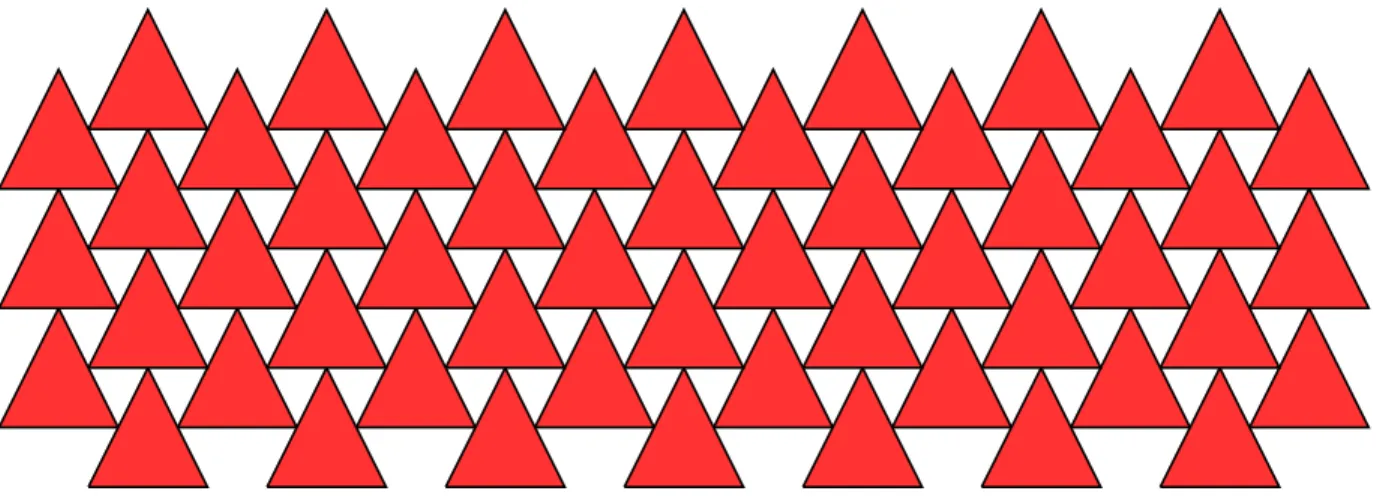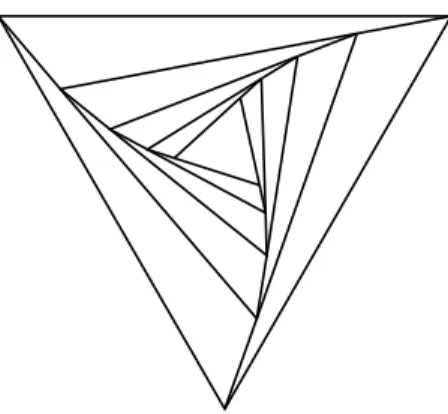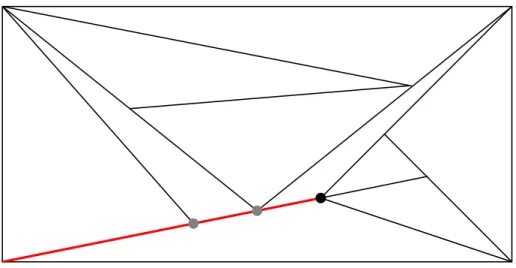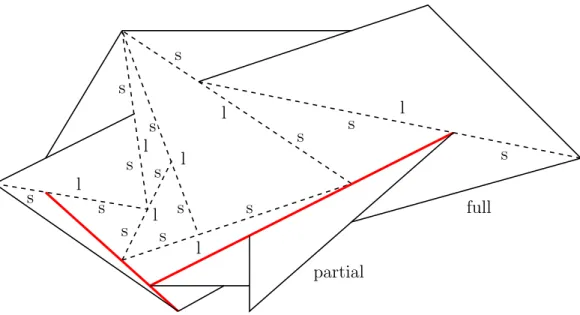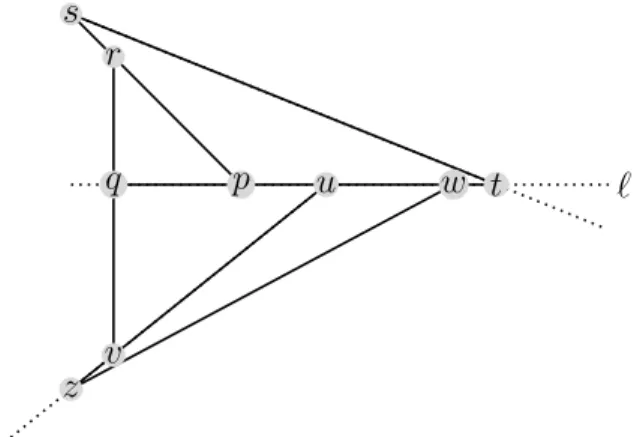arXiv:1711.04504v3 [math.CO] 11 Apr 2018
Tilings with noncongruent triangles
Andrey Kupavskii
∗J´anos Pach
†G´abor Tardos
‡Abstract
We solve a problem of R. Nandakumar by proving that there is no tiling of the plane with pairwise noncongruent triangles of equal area and equal perimeter. We also show that any tiling of a convex polygon with more than three sides with finitely many triangles contains a pair of triangles that share a full side.
1 Introduction
In his blog, R. Nandakumar [7, 8] raised several interesting questions on tilings. They have triggered a lot of research in geometry and topology. In particular, he and Ramana Rao [9]
conjectured that for every natural number n, any plane convex body can be partitioned into n convex pieces of equal area and perimeter. After some preliminary results [1, 5] indicating that the problem is closely related to questions in equivariant topology, the conjecture was settled in the affirmative by Blagojevi´c and Ziegler [2] in the special case where n is a prime power. All other cases, including the case n = 6, are open.
Nandakumar also asked the following interesting variant of the last question. A family of closed triangles that together cover the whole plane is said to form atiling if no two of its members share an interior point.
Problem 1. (Nandakumar [8]) Is it possible to tile the plane with pairwise noncongruent triangles of the same area and perimeter?
The aim of this note is to show that the answer to this question is in the negative.
Theorem 2. There is no tiling of the plane with pairwise noncongruent triangles of the same area and the same perimeter.
We start with a trivial observation.
∗EPFL, Lausanne and MIPT, Moscow. Supported in part by the grant N 15-01-03530 of the Russian Foundation for Basic Research and by the EPSRC grant no. EP/N019504/1. E-mail: kupavskii@ya.ru.
†EPFL, Lausanne and R´enyi Institute, Budapest. Supported by Swiss National Science Foundation Grants 200020-162884 and 200021-165977. E-mail: pach@cims.nyu.edu.
‡R´enyi Institute and Central European University, Budapest. Supported by the Cryptography “Lend¨ulet”
project of the Hungarian Academy of Sciences and by the National Research, Development and Innovation Office, NKFIH, projects K-116769 and SNN-117879.
Figure 1: Periodic tiling with no two triangles sharing a side.
Observation 3. If two triangles of the same area and perimeter share a side, then they are congruent.
Indeed, if two triangles, xyz and xyz′, have the same perimeter, thenz and z′ must lie on a common ellipse with foci x and y. On the other hand, if their areas are also the same, the distances of z and z′ from the line xy line must be equal. Consequently, if xyz and xyz′ do not coincide, one can obtain one from the other by a reflection through the line xy, or the midpoint of the segment xy, or the orthogonal bisector of this segment.
Therefore, in order to prove Theorem 2, it is sufficient to establish the following result.
Theorem 4. Let T be tiling of the plane with triangles of unit perimeter, each of which has area at least ǫ >0. Then there are two triangles in T that share a side.
In the periodic tiling depicted in Fig. 1, no two triangles share a side. Therefore, Theo- rem 4 does not hold without the assumption that all triangles have the same perimeter.
Another way of enforcing that two triangles of a tiling share a side by imposing a condition on the lengths of the sides of the participating triangles. We say that a tiling islocally finite if any bounded region intersects only a finite number of its members.
Theorem 5. Let T be a locally finite tiling of the plane with triangles, and suppose that the lengths of their sides belong to interval [1,2). Then there are two triangles in T that share a side.
By properly scaling the tiling depicted in Fig. 1, we obtain an example showing that Theorem 5 does not remain true if we replace the interval [1,2) by its closure, [1,2].
One of the main ideas of the proof of Theorem 2 in a simplified form can be used to obtain a result on triangular tilings of a convex k-gon with k > 3.
Theorem 6. Let k ≥4. In any tiling of a convex k-gon with finitely many triangles, there are two triangles that share an edge.
We note that, while revising the paper, it was pointed out to us by Roman Karasev
Figure 2: Tiling a triangle with triangles not sharing a side. A triangle is recursively subdi- vided into 4 pieces.
...
Figure 3: Tiling of a square with infinitely many triangles, no pair of which share a side.
and Pavel Kozhevnikov that Theorem 6, for the case k = 4, was once posed on a Russian mathematics olympiad and was published in Kvant [6].
The tiling depicted in Figure 2 shows that Theorem 6 is false for k = 3. The tiling in Figure 3 shows that Theorem 6 does not hold for infinite tilings.
The rest of this note is organized as follows. In Section 2, we establish Theorem 6. The proof of Theorem 4 (which implies Theorem 2) is similar, but more involved. It requires careful asymptotic estimates of certain parameters and is presented in a separate section (Section 3). The proof of Theorem 5 is given in Section 4.
For many other problems on tilings, consult [3] and [8].
2 Tiling a convex polygon—Proof of Theorem 6
Consider a convex k-gon P which is tiled with t triangles such that no two of them share a side. In what follows, by a side we will always mean a side of one of the t triangles, so
that the total number of sides is 3t. We use the termvertex for the vertices of the triangles (including the vertices of P). Define a simple graph Gon this vertex set by connecting two vertices with an edge if the segment between them belongs to the side of a triangle and contains no other vertex.
Obviously, G is a connected planar graph with f(G) = t + 1 faces. The number of vertices of Gis v(G) =vbd+vint, where vbd and vint denote the number of vertices lying on the boundary ofP and in the interior of P, respectively, andvbd ≥k. By Euler’s polyhedral formula, the number of edges ofG satisfies
e(G) = v(G) +f(G)−2 =vbd+vint+t−1.
The number of edges along the boundary of P is vbd, and every edge in the interior of P belongs to the side of precisely two triangles. Denote byvint∗ ≤vint the number of vertices in the interior of P that subdivide (that is, lie in the interior of) a side of a triangle. In fact, each such vertex subdivides precisely one side. Double counting the edges, we obtain
2e(G) = 3t+v∗int+vbd. Comparing the last two equations gives
vbd + 2vint−vint∗ =t+ 2. (1) A minimal segment that can be decomposed into sides of triangles in two different ways is called astretch. The total number of triangles whose sides participate in such a decompo- sition (that is, lie along the stretch) is called the sizeof the stretch. Since no two triangles share a side, the size of every stretch is at least 3. If a stretch has size s, then there are preciselys−2≥ 3s vertices in its interior thatsubdividea side. Observe that each of the vint∗ vertices in the interior of P that subdivide a side lies in the interior of precisely one stretch.
Let Σ denote the sum of the sizes of all stretches. Since every side of a triangle, except for the vbd sides that lie on the boundary ofP, contributes precisely one to this sum (and those on the boundary contribute zero, due to convexity), we have that Σ = 3t−vbd. Along each stretch, the number of subdividing vertices is at least one-third of the size of the stretch.
Therefore, the total number of subdividing vertices is at least Σ3. That is, vint∗ ≥ 3t−vbd
3 =t− vbd
3 , whence
t≤v∗int+ vbd
3 . Plugging this inequality into (1), we obtain that
vbd + 3(vint−v∗int)≤3.
This can hold only if vbd = 3 andvint =vint∗ . In particular, k≤ vbd must also be equal to 3.
This completes the proof of Theorem 6.
Figure 4: Tiling of a rectangle with triangles. The thick segment is a stretch of size 4 with two subdividing vertices marked by grey dots. The only interior vertex which is not a subdividing vertex is marked by a black dot.
The above proof also shows that if P is a triangle (k = 3), then any tiling of P with triangles such that no two triangles share a sides satisfies that
(i) there is no vertex subdividing any side of P,
(ii) every vertex in the interior of P must subdivide a side, and (iii) the size of every stretch is exactly 3.
Despite all these limitations, for anyk >1, a triangle can be cut into 3k+ 1 smaller triangles in several different ways without having two pieces that share a side. For example, this can be achieved by recursively subdividing one of the triangles into 4 pieces; see, e.g., Fig. 2.
3 Equal perimeter tilings—Proof of Theorem 4
Here we extend the ideas of the proof of Theorem 6 given in the previous section from a finite tiling of a polygon to tilings of the whole plane. We start with a quick overview. Assume for a contradiction that there is a tiling with no pair of triangles sharing a side which satisfies the conditions in Theorem 4. We want to apply the computation described in the previous section to a large but bounded portion of this tiling. In general, we will not be able to apply Theorem 6 directly, because there is no guarantee that there exists a large part of the tiling whose union is a convex polygon. For this reason, as a “boundary effect”, some small error terms will creep into our calculations. Nevertheless, we will be able to conclude that, analogously to condition (iii) at the end of the last section, most stretches in the tiling have size 3. Out of the three sides along a stretch of size 3, one is as long as the other 2 combined.
We call the former side long, while the other two sides along the same stretch are called short. Of course, there may be a short side in one stretch that is much longer than a long side in another. Overall, there are twice as many short sides as long sides, but their total
lengths are exactly the same. We deduce a strong triangle inequality for the short and long sides of a single triangle. Summing up these inequalities for all triangles, and combining the obtained bound with the above facts, we will arrive at the desired contradiction. Next, we spell out the details of the proof.
Proof of Theorem 4. Assume for a contradiction that there is a tiling T∞ of the plane satisfying the conditions in Theorem 4, but not having two triangles that share a side. Since every triangle has area at least ǫ > 0 and unit perimeter, the tiling must be locally finite.
The perimeter of each triangle is 1, which implies that the areas of the triangles are also bounded from above, by the constant δ = √
3/36. Moreover, each side of a triangle has to be longer than ǫ′ = 4ǫ, otherwise, its area would be smaller thanǫ. At the end of the proof, we will use the following strong triangle inequality: the total length of any two sides of a triangle in our tiling exceeds the length of the third side by at least some fixed ǫ′′ >0. The existence of such ǫ′′ follows from a compactness argument.
For the rest of the proof, we think of ǫ, δ, ǫ′, and ǫ′′ as fixed positive constants. Their exact values are not relevant for our argument.
Letr >0 be a sufficiently large number to be specified later, and choose an open circular disk D(r) of radius r. Let T0 denote the family of all triangles in T ∈ T∞ that have a nonempty intersection with D(r). The union of these triangles is a connected set, but not necessarily simply connected. Filling up the possible holes with other triangles in T∞, we turn this set into a simply connected polygonal region P. Let T denote the family of all triangles T ∈ T∞ that belong to P. The union of these triangles is P. Let T′ ⊂ T∞ denote the family of triangles that touch the boundary of P from outside.
Since the diameter of every triangle is at most 1/2, all members of T′ lie in the annulus D(r+ 1)\D(r), where D(r+ 1) is the disk of radiusr+ 1 concentric with D(r). Using the above lower and upper bounds on the areas of the triangles, and denoting the number of triangles in T (and T′) byt (and t′, respectively), we have
t=|T | ≥ r2π
δ = Ω(r2), t′ =|T′| ≤ (r+ 1)2π−r2π
ǫ =O(r).
(2)
Here we use the asymptotic notation with respect the choice of r.
When speaking of vertices and sides, we mean the vertices and sides of the triangles in T. As no two triangles share a side, the total number of sides is 3t. Define a simple graph G on the set of vertices by connecting two vertices by an edge if the segment between them belongs to a side and contains no other vertex.
Obviously, Gis a connected planar graph with f(G) =t+ 1 faces, including the exterior face. Let v(G) and e(G) denote the number of vertices and the number of edges in G, respectively. By Euler’s polyhedral formula, we have
e(G) =v(G) +f(G)−2 =v(G) +t−1. (3)
Let us call an edge a boundary edge if it belongs to the boundary of the polygon P. A boundary edge is said to be full if it is the full side of a triangle in T, and partial if it is a proper part of a side. (Note that partial boundary edges did not show up in the proof of Theorem 6, because thereP was aconvex polygon.) Let efull and epart stand for the number of full and partial boundary edges, respectively.
Note that all boundary edges are contained in the union of the boundaries of the triangles inT′. The length of any side is at leastǫ′. Thus, in view of (2), the number of full boundary edges satisfies the inequality
efull ≤ t′
ǫ′ =O(r). (4)
To bound the number of partial boundary edges, it is enough to observe that every partial boundary edge contains a vertex of a triangle T ∈ T′, and any vertex of T belongs to at most one partial boundary edge. Hence, we have
epart ≤3t′ =O(r). (5)
A stretch is a minimal segment that can be decomposed into sides (of triangles in T) and partial boundary edges in two different ways. (Note that in the proof of Theorem 6 we did not have to include boundary edges in the definition of a stretch, because in that setting all stretches lied in the interior of P.) The number of sides belonging to (contained in) a stretch is called the size of the stretch. Observe that sides contained in the boundary of P (full boundary edges) do not belong to any stretch, but every other side belongs to a unique one. Thus, the total size of the stretches is equal 3t−efull. We call a stretch improper if it contains a partial boundary edge. Otherwise, it is called a proper stretch. The size of a proper stretch is at least 3, the size of an improper stretch is at least 2. We call a proper stretch of size 3 tight, and denote the number of tight stretches by σtight. A stretch is said to be loose if it is not tight. Let Lloose denote the total length of all loose stretches.
Summing up the lengths of tight and loose stretches, we obtain 3t−efull = 3σtight+Lloose,
whence
t =σtight+ Lloose
3 +efull
3 . (6)
A vertex is calledsubdividingif it is the interior point of a side. Letv∗ denote the number of subdividing vertices. A subdividing vertex is an interior point of a single side and, hence, of a single stretch. As in the proof of Theorem 6, the number of subdividing vertices in the interior of a proper stretch of size s is exactly s−2. The number of subdividing vertices of an improper stretch of size s is at least s−1. Thus, any loose stretch of size s has at least s/2 subdividing vertices. Hence, the total number of subdividing vertices satisfies
v∗ ≥σtight +Lloose
2 . (7)
s s
l s s
l l s
s l
s s
s
s l
l
s s
s l
s
partial
full
Figure 5: Part of a tiling without two triangles sharing an edge. The short and long parts of each tight stretch (dashed) are marked by s and l, respectively. Loose stretches are marked thick and red. One partial and one full boundary edge is marked.
The sum of the number of edges on all faces of G is equal to 2e(G). The ttriangles have 3t+v∗ edges in total, while the infinite face has efull+epart edges (namely, the boundary edges). Hence,
2e(G) = 3t+v∗+efull+epart. (8) Comparing this with (3), we get 2v∗+ 2t−2≤2e(G) = 3t+v∗+efull+epart, so that
v∗ ≤t+efull+epart+ 2.
If we plug into this inequality the estimates (6) and (7), we conclude that Lloose ≤8efull+ 6epart+ 12.
Taking (4) and (5) into account, this implies
Lloose =O(r). (9)
Since the number of sides on loose stretches as well as the number of sides that are full boundary edges isO(r), we should concentrate on the tight stretches containing most of the 3t= Ω(r2) sides. We call the longest side on any tight stretch long and the other two sides on the same tight stretchshort. The sides not belonging to any tight stretch are neither long nor short.
Along each tight stretch, the length of the long side is equal to the sum of the lengths of the two short sides. Therefore, the total length of all short sides is the same as the total length of all long sides. Define the quantity W as
W =
2
3 −ǫ′′
(#long sides)− 1
3(#short sides)
+ (total length of short sides)−(total length of long sides).
Since each tight stretch has one long and two short sides, we have #long sides = σtight
and #short sides = 2σtight. The last two terms of W cancel out. Thus,
W =−ǫ′′σtight. (10)
On the other hand, we can compute W by adding up the contributions of the triangles T ∈ T. We classify the triangles inT as follows. If a triangle has a side that it neither short, nor long, we call it exceptional. If T is not exceptional and it has i long sides, we say that T is oftype i, for i= 0,1,2,3. If T is of
type 0, its contribution to W is 0, as the total length of its short sides is the perimeter of T, which is equal to 13(#short sides of T) = 1.
type 1, its contribution to W is the total length of its two short sides minus the length of its long side minus ǫ′′, which is nonnegative, according to the definition of ǫ′′.
type 2, its contribution toW is 2(length of its short side)−2ǫ′′≥2ǫ′−2ǫ′′ ≥0.
type 3, its contribution toW is equal to 1−3ǫ′′ >0.
The only triangles whose contribution to W can be negative are the exceptional ones.
The contribution of each exceptional triangle is is at least−23. The number of these triangles inT is at most Lloose+efull, so by (4) and (9) we obtain−W =O(r). Comparing this bound to (10), we have
σtight =O(r).
Plugging (4), (9), and this bound into (6), we conclude that t=O(r), which contradicts (2).
The contradiction proves the theorem.
4 Triangles with similar sides—Proof of Theorem 5
Theorem 5 is an easy corollary to the following result.
Theorem 7. In any locally finite tiling of the plane with triangles, there is a triangle with a side that is the union of one or more sides of other triangles.
Proof. Assume we have a tilingT contradicting the statement of the theorem, and let pst be any triangle inT. Aspt cannot be obtained as the union of sides of other triangles, por t must be an interior point of a side of another triangle along the linept. Similar statements are true for the other two sides of the trianglepst, but no vertex can be an interior point of more than one side in the tiling. Thus, there are three triangles along the lines pt, ts, and sp, that contain p,t, ands, respectively, in this cyclicorder. Similar statements hold for all triangles in the tiling.
p ℓ s
t r
q
v
u w
z
Figure 6: Illustration for the proof of Theorem 7.
We have seen that there is a unique triangle T ∈ T that has p as an interior point of one of its sides. Assume without loss of generality that this side of T belongs to the line ℓ containing pt. Notice that there is precisely one other triangle in T, different from pst, whose vertex is p, and this triangle must also have a side contained in ℓ. (Indeed, if there were a triangle in T with p as a vertex that does not have a side contained in ℓ, it would not satisfy the cyclic property described in the previous paragraph.) In the same way, for any other vertex p′ of the tiling, there are precisely two triangles with this vertex, and there is a line that contains one side of each. Let pqr and pst be the two triangles containing pas a vertex, where p, r, and s are collinear; see Figure 6.
Sincep is an interior point of a side alongℓ, we conclude thatqmust be an interior point of a side along the line qr and t must be an interior point of a side along the line st. Let quv be the other triangle with vertex q along ℓ, where v lies on the line qr. As q is not an interior point of a side along the line ℓ, so u must be an interior point of a side along ℓ:
either of the side qp or of pt (as the line ℓ is “blocked” by another triangle at t). Finally, consider the other triangle of the tiling that has u as a vertex. It must have another vertex walongℓ (in fact, in the segmentut, becauseℓis “blocked” att) and a third vertex z on the ray emanating from u toward v (see Figure 6). Now u is the interior point of a side along ℓ, so w must be an interior point of a side along the linewz. This is possible only if w= t and z lies on the line st, because this is the first line “blocking” ℓ. The ray from u toward v (containing z) does not intersect the line st (which is also supposed to contain z). This contradiction proves the theorem.
Two triangles of a locally finite triangular tiling T are called neighbors if they share a boundary segment. It follows from the proof of the last theorem that for any triangleT ∈ T, either T itself, or one of its neighbors, second neighbors, or third neighbors has a side that is the union of one or more sides of other triangles.
References
[1] I. B´ar´any, P. Blagojevi´c, and A. Sz˝ucs: Equipartitioning by a convex 3-fan, Advances in Math. 223 (2010), 579–593.
[2] P. Blagojevi´c and G. Ziegler: Convex equipartitions via equivariant obstruction the- ory, Israel J. Math.200 (2014), no. 1, 49–77.
[3] P. Brass, W. Moser, and J. Pach: Research Problems in Discrete Geometry, Springer, New York, 2005.
[4] D. Frettl¨oh: Noncongruent equidissections of the plane,M.D.E. Conder, A. Deza, A.I.
Weiss (Eds.): Discrete Geometry and Symmetry, Veszpr´em, Hungary, June 2015, Springer Proceedings in Mathematics & Statistics, Vol. 234 (2018).
[5] R. Karasev, A. Hubard, and B. Aronov: Convex equipartitions: the spicy chicken theorem, Geom. Dedicata170 (2014), 263–279.
[6] Kvant (1975) N4, p. 26, problem M320 (in Russian),
http://kvant.ras.ru/1975/04/zadachnik_kvanta_matematika.htm
[7] R. Nandakumar: Fair partitions, Blog entry, http://nandacumar.blogspot.de, September 28, 2006.
[8] R. Nandakumar: Filling the plane with non-congruent pieces, Blog entries, http://nandacumar.blogspot.in, December 2014, January 2015, June 2016.
[9] R. Nandakumar and N. Ramana Rao: Fair partitions of polygons: An elementary introduction, Proc. Indian Academy of Sciences (Mathematical Sciences) 122(2012), 459–467.
